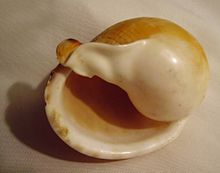Callus (mollusc)
Appearance
This article needs additional citations for verification. (August 2011) |

A callus is an anatomical feature that exists in some mollusk shells, a thickened area of shell material that can partly or completely cover the umbilicus, or can be located as a coating on the body whorl near the aperture of the shell (i.e. a parietal callus or columellar callus).
A callus exists in the shells of various species of gastropods (snails) and also in the shells of several species of Nautilus, a cephalopod.

A callum is an anatomical feature of some mature bivalve shells of species in the family Pholadidae, the piddocks.[1] The callum is an area of shell material that fills the gap between the two valves.[2]
References
- ^ "Corns and calluses: Symptoms, diagnosis and treatment". Retrieved 2017-08-15.
{{cite news}}: Cite has empty unknown parameter:|dead-url=(help) - ^ Definitions of terms for parts of gastropod shell
Look up callus in Wiktionary, the free dictionary.



